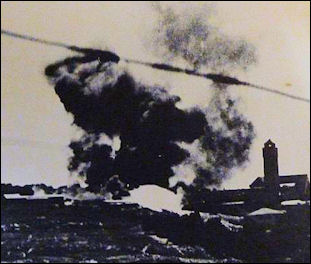COMBATING TERRORISM
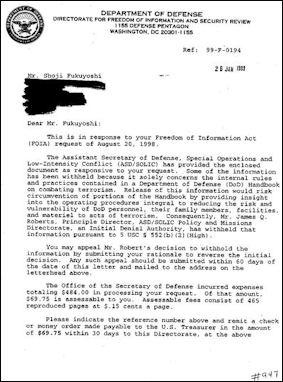
Analysts believe that terrorism will only be defeated with an effort that combines military action with social programs that address Muslim grievances, poverty and anti-American sentiments. Some have pushed for a “two pronged approach” that combines a campaign against terrorists with an effort to reach out to moderate Muslims and address issues like the Israeli-Palestinian conflict in way that Muslim would see as favorable.
But despite all this no one is sure what policies if any would help defeat the Muslim extremists and militants. Moreover, efforts by the West to win the hearts and minds of Muslims who have anti-Western views don’t seem to work very well and often come across as propaganda. Hardline anti-terrorist policies often backfire or are counterproductive, many believe, making the problem worse by providing fodder for new recruits and driving the movements underground where they are difficult to combat. Many see the current situation as a stalemate with the militant groups unable to carry out spectacular attacks but the Americans and the West unable to defeat the militants.
"Countering terrorism is not a task that any country can achieve on its own," U.S. Secretary of State Hillary Rodham Clinton said, it "calls for all nations to be vigilant and creative, as well as receptive to new ideas and willing to set aside failed strategies...We are far more likely to succeed in thwarting terrorist networks like al-Qaida and its syndicate organizations if we work together to track their actions...These groups have a global view and we must have one too that begins with a shared understanding of the big picture." [Source: Anita Snow, The Associated Press, September 2010]
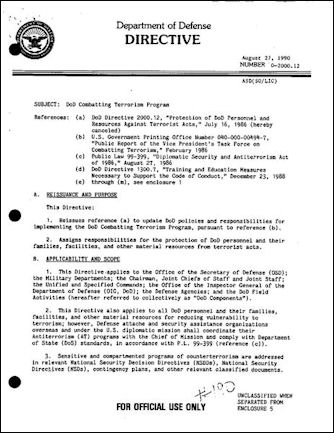
Combating Terrorism Program
Department of Defense "There is a worrying increase in the number of vulnerable states and regions where terrorist groups find ample opportunity to recruit, train and plot attacks," said Turkish Foreign Minister Ahiviet Davutoglu. "The U.N., in particular the Security Council, needs to ensure that its focus goes beyond combating terrorism. It should be more comprehensive and focus also on efforts geared toward preventing terrorism."
After Al-Qaida decentralized after September 11th the group became less capable in may ways of carrying out large attacks but it also became more difficult to attack as activities became concentrated in cells instead of through a central hierarchy. If one cell was stopped the other could keep operating.
Drone attacks and a successful squeeze on Al-Qaida’s cash supplies, according to U.S. intelligence officials in 2010, has limited the group’s ability to launch ambitious, complex terrorist attacks. CIA director at the time Leon Paneta said, “Intelligence confirms that they are finding it difficult to be able to engage in planning and command-and-control operations to put together a large attack.” But intelligence officials, wrote Joby Warrick and Peter Finn of the Washington Post, also warned of worrisome new evidence of al-Qaeda's ability to adapt. In an annual "threat assessment" to Congress, spy agencies described the emerging threat as more geographically dispersed and also low-tech, favoring lone operatives and conventional explosives. [Source: Joby Warrick and Peter Finn, Washington Post, February 8, 2010]
A study by Syracuse University’s Transactional Records Clearinghouse released in December 2003, about 6,4000 people were questioned by investigators on criminal charges related to terrorism. Of theses a third were charged and only 879 were convicted, mostly on minor charges. The average prison sentence was only 14 days. Only five people were sentenced to 20 years or more.
Books: “The U.S. Army/Marine Corps Counterinsurgency Field Manual” (University of Chicago, paper, $15); “Containment: Rebuilding a Strategy Against Global Terror” by Ian Shapiro (Princeton University, 2007) ; “Terrorist Hunter” by Rita Katz (HarperCollins)
Bruce Hoffman’s Advice on Fighting Terrorism
Offering his suggestions on how to fight terrorism, terrorism expert Bruce Hoffman wrote in The Atlantic Monthly: The police, the military, and intelligence agencies can take steps that work from the outside in, beginning far in time and distance from a potential attack and ending at the moment and the site of an actual attack. Although the importance of these steps is widely recognized, they have been implemented only unevenly across the United States. [Source: Bruce Hoffman, The Atlantic Monthly, June 2003; Hoffman is a professor at Georgetown University and author of "Inside Terrorism."]
1) “Understand the terrorists' operational environment. Know their modus operandi and targeting patterns. Suicide bombers are rarely lone outlaws; they are preceded by long logistical trails. Focus not just on suspected bombers but on the infrastructure required to launch and sustain suicide-bombing campaigns. This is the essential spadework. It will be for naught, however, if concerted efforts are not made to circulate this information quickly and systematically among federal, state, and local authorities.
2) “Develop strong, confidence-building ties with the communities from which terrorists are most likely to come, and mount communications campaigns to eradicate support from these communities. The most effective and useful intelligence comes from places where terrorists conceal themselves and seek to establish and hide their infrastructure. Law-enforcement officers should actively encourage and cultivate cooperation in a nonthreatening way.
3) “Encourage businesses from which terrorists can obtain bomb-making components to alert authorities if they notice large purchases of, for example, ammonium nitrate fertilizer; pipes, batteries, and wires; or chemicals commonly used to fabricate explosives. Information about customers who simply inquire about any of these materials can also be extremely useful to the police.

Vectors for introduction of threats
4) “Force terrorists to pay more attention to their own organizational security than to planning and carrying out attacks. The greatest benefit is in disrupting pre-attack operations. Given the highly fluid, international threat the United States faces, counterterrorism units, dedicated to identifying and targeting the intelligence-gathering and reconnaissance activities of terrorist organizations, should be established here within existing law-enforcement agencies. These units should be especially aware of places where organizations frequently recruit new members and the bombers themselves, such as community centers, social clubs, schools, and religious institutions.
5) “Make sure ordinary materials don't become shrapnel. Some steps to build up physical defenses were taken after 9/11 — reinforcing park benches, erecting Jersey barriers around vulnerable buildings, and the like. More are needed, such as ensuring that windows on buses and subway cars are shatterproof, and that seats and other accoutrements are not easily dislodged or splintered. Israel has had to learn to examine every element of its public infrastructure. Israeli buses and bus shelters are austere for a reason.
6) Teach law-enforcement personnel what to do at the moment of an attack or an attempt. Prevention comes first from the cop on the beat, who will be forced to make instant life-and-death decisions affecting those nearby. Rigorous training is needed for identifying a potential suicide bomber, confronting a suspect, and responding and securing the area around the attack site in the event of an explosion. Is the officer authorized to take action on sighting a suspected bomber, or must a supervisor or special unit be called first? Policies and procedures must be established. In the aftermath of a blast the police must determine whether emergency medical crews and firefighters may enter the site; concerns about a follow-up attack can dictate that first responders be held back until the area is secured. The ability to make such lightning determinations requires training — and, tragically, experience. We can learn from foreign countries with long experience of suicide bombings, such as Israel and Sri Lanka, and also from our own responses in the past to other types of terrorist attacks.
U.S. Army/Marine Corps Counterinsurgency Field Manual
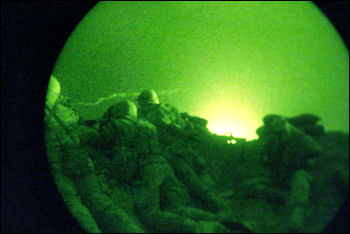
Firefight in Kandahar The U.S. Army/Marine Corps Counterinsurgency Field Manual was released as a government document in December 2006, but owing to its enormous popularity (1.5 million downloads in the first month alone), it has now been published by a university press, with a provocative, highly readable new foreword and introduction that testify to the manual’s “paradigm-shattering” content. [Source: Samantha Power, New York Times, July 29, 2007]
Discussing some of the main points and the background of the manual, Samantha Power wrote in New York Times: “When the terrorists struck on 9/11, the United States military was singularly unprepared to deal with them. One reflection of the Pentagon’s mind-set at the time was the fact that the Army counterinsurgency manual had not been updated since 1986 and the Marine Corps guide had not been revised since 1980. This lack of preparedness showed. In Afghanistan and Iraq, the armed forces did not have the appropriate intelligence, linguistic capabilities, weapons, equipment, force structures, civil affairs know-how or capacity to train security forces in other countries. “It is not unfair to say that in 2003 most Army officers knew more about the U.S. Civil War than they did about counterinsurgency,” Lt. Col. John A. Nagl writes in the foreword to the University of Chicago edition. But while the Bush administration dug in, refusing to admit how ill-suited its premises were to the new century, American military officers revised their old doctrines on the fly.
“The leading architect of the manual was David Petraeus, then a lieutenant general, who commanded the 101st Airborne Division in the initial invasion of Iraq in 2003 and took responsibility for governing Mosul, Iraq’s second-largest city, immediately thereafter. [He later became the overall American commander in Iraq and then Afghanistan ]. Petraeus emphasized economic and political development and is said to have asked his soldiers, “What have you done for the people of Iraq today?” He worked with another military man who also saw that his job would have to be more than strictly military — Lt. Gen. James Mattis, who commanded the First Marine Division during the initial invasion and then in 2004 returned to help stabilize Anbar Province. His division motto was “No Better Friend, No Worse Enemy — First Do No Harm.” In February 2006, while the new counterinsurgency doctrine was still being drafted, and while international criticism of American military excesses mounted, Petraeus invited journalists, human rights lawyers, academics and practitioners of counterinsurgency to Fort Levenworth to vet a draft, initiating what participants characterized as one of the most open and productive exchanges of ideas they had ever witnessed.
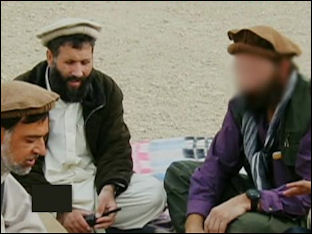
meeting with locals in Tora Bora “The fundamental premise of the manual is that the key to successful counterinsurgency is protecting civilians. The manual notes: “An operation that kills five insurgents is counterproductive if collateral damage leads to the recruitment of 50 more insurgents.” It suggests that force size be calculated in relation not to the enemy, but to inhabitants (a minimum of 20 counterinsurgents per 1,000 residents). It emphasizes the necessity of coordination with beefed-up civilian agencies, which are needed to take on reconstruction and development tasks.
The most counterintuitive, as well as the most politically difficult, premise of the manual is that the American military must assume greater risk in order to gather much-needed intelligence and, in the end, achieve greater safety. The emphasis of the 1990s on force protection is overturned by the assertion of several breathtaking paradoxes: “Sometimes, the more you protect your force, the less secure you may be.” “Sometimes, the more force is used, the less effective it is.” “Sometimes doing nothing is the best reaction.”
Sarah Sewall, a former Pentagon official who teaches at the Kennedy School of Government at Harvard University, and contributor the manual’s introduction, addresses the concern that the manual is nothing more than a “marketing campaign for an inherently inhumane concept of war,” arguing that if politicians continue to put young American men and women in harm’s way, military leaders have an obligation to enhance effectiveness, which in a globalized era cannot be disentangled from taking better care of civilians. Military actions that cause civilian deaths, she argues, are not simply morally questionable; they are self-defeating.
But Sewall explains that even if the military can overcome the substantial challenges of executing such a counterintuitive doctrine — and here the near-daily reports of large-scale civilian loss of life as a result of United States counterinsurgency operations in Afghanistan and Iraq are a reminder of the yawning gap between theory and practice — it will not succeed if it does not get the civilian leadership and support it needs. The military does not have the expertise to perform the range of economic and political tasks associated with nation-building, but in Iraq and Afghanistan, as civilian reconstruction teams went unstaffed, it was forced to pinch-hit. Sewall rightly calls for the “risks and costs of counterinsurgency” to be spread across the American government, but notes this is not an overnight job. “More people play in Army bands than serve in the U.S. foreign service,” she writes....The manual shows that the demands of counterinsurgency are greater than those the American public has yet been asked to bear. Sewall is skeptical that the public...will muster the will,to “supply greater concentrations of forces, accept higher casualties, fund serious nation-building and stay many long years to conduct counterinsurgency by the book.”
Book: “The U.S. Army/Marine Corps Counterinsurgency Field Manual” (University of Chicago, paper, $15)
Is Terrorism Really Rooted in Middle East Conflicts?
Six-Day War Olivier Roy wrote in the New York Times: “Are the roots of Islamic terrorism in the Middle Eastern conflicts? If the answer is yes, the solution is simple to formulate, although not to achieve: Leave Afghanistan and Iraq, solve the Israel-Palestine conflict. But if the answer is no, as I suspect it is, we should look deeper into the radicalization of young, Westernized Muslims. [Source: Olivier Roy, New York Times, Saturday, July 23, 2005. Roy is a professor at the School for Advanced Studies in the Social Sciences and author of “Globalized Islam”]
“Conflicts in the Middle East have a tremendous impact on Muslim public opinion worldwide. In justifying its terrorist attacks by referring to Iraq, Al Qaeda is looking for popularity or at least legitimacy among Muslims. But many of the terrorist group's statements, actions and non-actions indicate that this is largely propaganda, and that Iraq, Afghanistan and Palestine are hardly the motivating factors behind its global jihad.
“First, let's consider the chronology. The Americans went to Iraq and Afghanistan after Sept. 11, not before. Mohamed Atta and the other pilots were not driven by Iraq or Afghanistan. Were they then driven by the plight of the Palestinians? It seems unlikely. After all, the attack was plotted well before the second intifada began in September 2000, at a time of relative optimism in Israeli-Palestinian negotiations. Another motivating factor, we are told, was the presence of "infidel" troops in Islam's holy lands. Yes, Osama bin Laden was reported to be upset when the Saudi royal family allowed Western troops into the kingdom before the Persian Gulf war. But bin Laden was by that time a veteran fighter committed to global jihad...Abdullah Azzam, bin Laden's mentor, gave up supporting the Palestinian Liberation Organization long before his death in 1989 because he felt that to fight for a localized political cause was to forsake the real jihad, which he felt should be international and religious in character. From the beginning, Al Qaeda's fighters were global jihadists, and their favored battlegrounds have been outside the Middle East: Afghanistan, Bosnia, Chechnya and Kashmir. For them, every conflict is simply a part of the Western encroachment on the Muslim ummah, the worldwide community of believers.
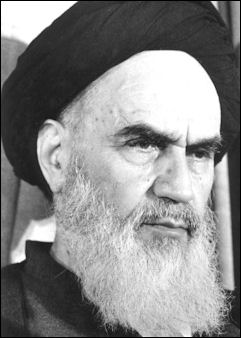
Ayatollah Khomeni “Second, if the conflicts in Afghanistan, Iraq and Palestine are at the core of the radicalization, why are there virtually no Afghans, Iraqis or Palestinians among the terrorists? Rather, the bombers are mostly from the Arabian Peninsula, North Africa, Egypt and Pakistan - or they are Western-born converts to Islam. Why would a Pakistani or a Spaniard be more angry than an Afghan about American troops in Afghanistan? It is precisely because they do not care about Afghanistan as such, but see the U.S. involvement there as part of a global phenomenon of cultural domination.
“What was true for the first generation of Al Qaeda is also relevant for the present generation: even if these young men are from Middle Eastern or South Asian families, they are for the most part Westernized Muslims living or even born in Europe who turn to radical Islam. Moreover, converts are to be found in almost every Qaeda cell: They did not turn fundamentalist because of Iraq, but because they felt excluded from Western society (this is especially true of the many converts from the Caribbean islands, both in Britain and France). "Born again" or converts, they are rebels looking for a cause. They find it in the dream of a virtual, universal ummah, the same way the ultraleftists of the 1970s (the Baader-Meinhof Gang, the Italian Red Brigades) cast their terrorist actions in the name of the "world proletariat" and "Revolution" without really caring about what would happen after.
It is also interesting to note that none of the Islamic terrorists captured so far had been active in any legitimate antiwar movements or even in organized political support for the people they claim to be fighting for. They don't distribute leaflets or collect money for hospitals and schools. They do not have a rational strategy to push for the interests of the Iraqi or Palestinian people. Even their calls for the withdrawal of the European troops from Iraq ring false. After all, the Spanish police have foiled terrorist attempts in Madrid even since the government withdrew its forces. Western-based radicals strike where they are living, not where they are instructed to or where it will have the greatest political effect on behalf of their nominal causes.The Western-based Islamic terrorists are not the militant vanguard of the Muslim community; they are a lost generation, unmoored from traditional societies and cultures, frustrated by a Western society that does not meet their expectations. And their vision of a global ummah is both a mirror of and a form of revenge against the globalization that has made them what they are.
Combating the Ideology of Terrorism
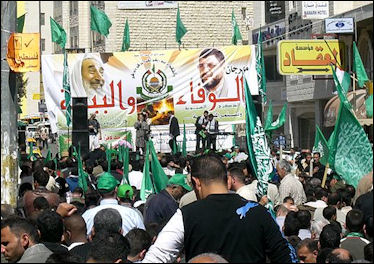
Hamas Rally Many think the best way to tackle radical Islam is to combat the ideology, poverty and circumstances that seem to help it breed. Forensic psychologist Marc Sageman wrote in the Los Angeles Times: “Idea-based networks can only be attacked through a war of ideas. The jihadist vision that has inspired terrorism must be taken on, and Muslims worldwide must be engaged to help in the fight. The aim is to alter Muslims perceptions that their interests are hostile to the West” by “de-legitimizing terrorist ideas” and “promoting an alternative vision of a just and fair Islamic society living in harmony with the West.”
“Many feel that the problem of terrorism will not be solved until Muslims begin reigning in their own instead of making excuse, blaming others and complaining about injustice and unfairness. Many feel that the West has to counter accusations made against it with good arguments of its own. Some say that one of the strategies that the United States can employ is to highlight the freedoms that Muslims are allowed in America, where they practice their faith as the wish. American Muslims: 1) enjoy freedom of religion, as do practitioners of all faiths; 2) can wear head scarves to work and to schools if they so choose; and are supported by laws that require employers to make “reasonable accommodation” for workers to practice their religion, in the case of Muslims, giving them time and a place to pray.
“Once a group takes on a religious mantle they are difficult to battle because any criticism of them is regarded as a condemnation of God or the religion in question. This condition seems true not just with jihadists and Muslim fundamentalists but with many religious extremist groups and cults.
“The Bush administration argued that by pushing democracy and American values will ultimately reduce terrorism. Studies have shown, however, that terrorist acts are more likely to occur in democracies. This seems true in part because terrorists can operate more freely in democracies than they can under repressive regimes. It has been argued that terrorists don’t really care about freedom or democracy what concerns them the most is foreign domination. Terrorist groups have few chances of winning elections; they find that terrorism suits their needs better that the political process.
Containment and Exploiting Divisions as a Strategy Against Global Terror
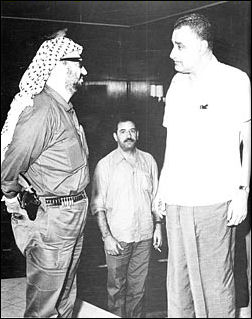
Arafat, Nasser and Abu Jihad
at Arab conference in the 1960s Samantha Power wrote in the New York Times: “Ian Shapiro, a professor of political science at Yale, believes American foreign policy as a whole must vastly increase its legitimacy if it is to defang terrorists in the long term. For this to happen, he argues in his book “CONTAINMENT: Rebuilding a Strategy Against Global Terror” for a return to the cold war rubric of “containment” — a halfway house between “appeasement and the chimerical aspiration to achieve U.S. control over the global security environment.” [Source: Samantha Power, New York Times, July 29, 2007]
“Shapiro shows how aggressive action has played into the hands of terrorist recruiters. When vital interests are imperiled, war may be necessary, he concedes. But generally the United States will invite fewer threats if, rather than attempting to achieve military hegemony, it employs economic, political and law-enforcement tools. “The idea behind containment,” Shapiro writes, “is to refuse to be bullied, while at the same time declining to become a bully.” Shapiro is at his most persuasive when he argues against lumping Islamic radical threats together. He points out that at the time of the cold war, George Kennan, the formulator of the containment policy, warned against treating Communism as a monolith. Policy makers, Kennan said, ought to emphasize the differences among and within Communist groups and “contribute to the widening of these rifts without assuming responsibility.”
“Although it is tempting to feel overwhelmed by the diversity of the threats aligned against the United States, Shapiro says that very diversity presents us with opportunities, since it “creates tensions among our adversaries” agendas, as well as openings for competition among them.” To pry apart violent Islamic radicals, the United States has to become knowledgeable about internal cleavages and be patient in exploiting them. Arguably, this is what American forces in Iraq are doing belatedly — and perilously — as they undertake the high-risk approach of turning Sunni ex-Baathists against Qaeda forces.
“Shapiro argues...that the United States must learn to get inside the minds of its enemies, to try to see the world as they do. Take Iran, for example. A Bush administration that had stepped into Iran’s shoes might have toned down its inflammatory rhetoric, having seen that the American occupations of Afghanistan and Iraq would be, in Shapiro’s words, “as if the Soviet Union had occupied Canada and Mexico at the height of the cold war, and had its fleet anchored off Cuba.” United States intelligence capacities, he says, must be revamped so that policy makers in Washington can guard against a “propensity to confuse leaders the United States might regard as desirable with leaders who actually enjoy legitimacy on the ground.”
“In addition, for containment to work, Washington needs to be able to deliver credible threats. The irony of Bush’s flawed approach is that it has exposed the limits of American enforcement tools, stretching military and financial resources beyond recognition. This has a doubly negative effect: it emboldens those who need to be contained, and it deters those we once might have counted on for help in doing the containing.
Book: “Containment: Rebuilding a Strategy Against Global Terror” by Ian Shapiro (Princeton University, 2007)
Old School, Cold War Tactics Used to Fight Terrorism
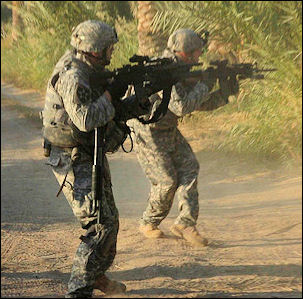
Firefight at Al-Qaida Safehouse Eric Schmitt and Thom Shanker wrote in the New York Times: “Military and intelligence officials assigned to counterterrorism say there is reason to believe that a combination of efforts could in fact establish something akin to the posture of deterrence, the strategy that helped protect the United States from a Soviet nuclear attack during the cold war. A primary focus has become cyberspace, which is the global safe haven of terrorist networks. To counter efforts by terrorists to plot attacks, raise money and recruit new members on the Internet, the government has mounted a secret campaign to plant bogus e-mail messages and Web site postings, with the intent to sow confusion, dissent and distrust among militant organizations, officials confirm. At the same time, American diplomats are quietly working behind the scenes with Middle Eastern partners to amplify the speeches and writings of prominent Islamic clerics who are renouncing terrorist violence. [Source: Eric Schmitt and Thom Shanker, New York Times, March 18, 2008]
“At the local level, the authorities are experimenting with new ways to keep potential terrorists off guard. In New York City, as many as 100 police officers in squad cars from every precinct converge twice daily at randomly selected times and at randomly selected sites, like Times Square or the financial district, to rehearse their response to a terrorist attack. City police officials say the operations are believed to be a crucial tactic to keep extremists guessing as to when and where a large police presence may materialize at any hour. “What we’ve developed since 9/11, in six or seven years, is a better understanding of the support that is necessary for terrorists, the network which provides that support, whether it’s financial or material or expertise,” said Michael E. Leiter, acting director of the National Counterterrorism Center. “We’ve now begun to develop more sophisticated thoughts about deterrence looking at each one of those individually,” Mr. Leiter said in an interview. “Terrorists don’t operate in a vacuum.”
“For obvious reasons, it is harder to deter terrorists than it was to deter a Soviet attack. Terrorists hold no obvious targets for American retaliation as Soviet cities, factories, military bases and silos were under the cold-war deterrence doctrine. And it is far harder to pinpoint the location of a terrorist group’s leaders than it was to identify the Kremlin offices of the Politburo bosses, making it all but impossible to deter attacks by credibly threatening a retaliatory attack.

Firefight at Al-Qaida Safehouse “Other types of “territory” that extremists hold dear, and they say they believe that one important aspect may be the terrorists’ reputation and credibility with Muslims. Under this theory, if the seeds of doubt can be planted in the mind of Al Qaeda’s strategic leadership that an attack would be viewed as a shameful murder of innocents — or, even more effectively, that it would be an embarrassing failure — then the order may not be given, according to this new analysis. Senior officials acknowledge that it is difficult to prove what role these new tactics and strategies have played in thwarting plots or deterring Al Qaeda from attacking. Senior officials say there have been several successes using the new approaches, but many involve highly classified technical programs, including the cyberoperations, that they declined to detail.
“As the top Pentagon policy maker for special operations, Michael G. Vickers creates strategies for combating terrorism with specialized military forces, as well as for countering the proliferation of nuclear, biological or chemical weapons. Much of his planning is old school: how should the military’s most elite combat teams capture and kill terrorists? But with each passing day, more of his time is spent in the new world of terrorist deterrence theory, trying to figure out how to prevent attacks by persuading terrorist support networks — those who enable terrorists to operate — to refuse any kind of assistance to stateless agents of extremism. “Obviously, hard-core terrorists will be the hardest to deter,” Mr. Vickers said. “But if we can deter the support network — recruiters, financial supporters, local security providers and states who provide sanctuary — then we can start achieving a deterrent effect on the whole terrorist network and constrain terrorists’ ability to operate. “We have not deterred terrorists from their intention to do us great harm,” Mr. Vickers said, “but by constraining their means and taking away various tools, we approach the overall deterrent effect we want.” Much effort is being spent on perfecting technical systems that can identify the source of unconventional weapons or their components regardless of where they are found — and letting nations around the world know the United States has this ability.
War on Terrorism Backfiring and Shortcomings of the American Anti-Terrorism Effort
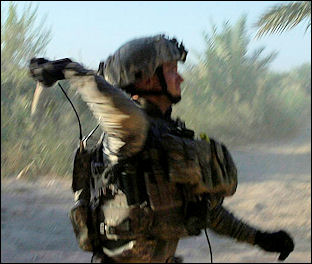
Firefight at Al-Qaida Safehouse AFP reported: “The US-led and British-backed war on terror is only fuelling more violence by focusing on military solutions rather than on root causes, a think tank warned Wednesday."The 'war on terror' is failing and actually increasing the likelihood of more terrorist attacks," the Oxford Research Group said in its study, titled "Beyond Terror: The Truth About The Real Threats To Our World." It said Britain and the United States have used military might to try to "keep the lid on" problems rather than trying to uproot the causes of terrorism. [Source: AFP, April 11, 2007]
“It said such an approach, particularly the 2003 invasion of Iraq, had actually heightened the risk of further terrorist atrocities on the scale of September 11, 2001. "Treating Iraq as part of the war on terror only spawned new terror in the region and created a combat training zone for jihadists," the report's authors argued. It pointed out that the Islamist Taliban movement is now resurgent, six years after it was overthrown in 2001 by the US-led invasion in the wake of the September 11 attacks.
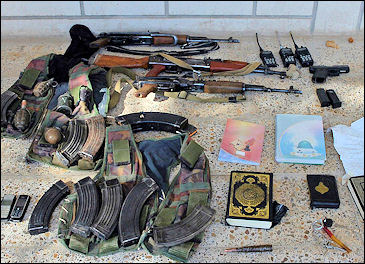
Firefight at Al-Qaida Safehouse Samantha Power wrote in the New York Times: Defense Secretary Donald Rumsfeld offered perhaps the best standard by which to measure the Bush administration’s performance: “Are we capturing, killing or deterring and dissuading more terrorists every day than the madrassas and the radical clerics are recruiting, training and deploying against us?” Leaked intelligence reports have shown that the answer is negative. The administration’s tactical and strategic blunders have crippled American military readiness; exposed vulnerabilities in training, equipment and force structure; and accelerated terrorist recruitment. In short, although the United States has not been directly hit since 9/11, we are less safe as a result of the Bush administration’s rhetoric, conduct and strategy. [Source: Samantha Power, New York Times, July 29, 2007]
In 2011, Reuters reported: Despite intense focus on Afghanistan, Pakistan and the Middle East in the last decade, U.S. spy agencies are still lacking in language skills needed to talk to locals, translate intercepted intelligence and analyze data, according to top intelligence officials. Intelligence agencies have had to face the reality that the languages they need cannot be taught quickly, the street slang U.S. operatives and analysts require is not easy, and security concerns make the clearance process slow-going. As recently as 2008 and 2009, intelligence officials were still issuing new directives and programs in the hopes of ramping up language capability. "Language will continue to be a challenge for us," Director of National Intelligence James Clapper said at a congressional hearing last week. "It's something we're working at, and will continue to do so, but we're probably not where we want to be," he said.
Terrorist Resistance to Fighting Terrorism
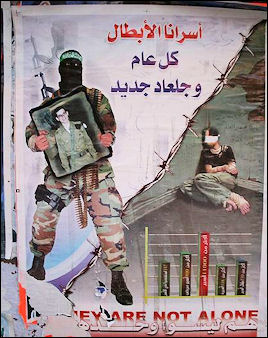
Hamas poster Bruce Hoffman wrote in The Atlantic Monthly: “The greatest military onslaught in history against a terrorist group crushed the infrastructure of al Qaeda in Afghanistan, depriving it of training camps, operational bases, and command-and-control headquarters; killing and wounding many of its leaders and fighters; and dispersing the survivors. Yet this group still actively seeks to rally its forces and attract recruits.[Source: Bruce Hoffman, The Atlantic Monthly, June 2003]
“Ayman Zawahiri, bin Laden's chief lieutenant, laid out a list of terrorist principles in his book, Knights Under the Prophet's Banner (2001), prominent among them the need for al Qaeda to "move the battle to the enemy's ground to burn the hands of those who ignite fire in our countries." He also mentioned "the need to concentrate on the method of martyrdom operations as the most successful way of inflicting damage against the opponent and the least costly to the mujahideen in terms of casualties."
“Exactly what shape that struggle will take remains to be seen. But a recruitment video reportedly circulated by al Qaeda...may provide some important clues. The seven-minute tape, seized from an al Qaeda member by U.S. authorities, extols the virtues of martyrdom and solicits recruits to Osama bin Laden's cause. It depicts scenes of jihadists in combat, followed by the successive images of twenty-seven martyrs with their names, where they were from, and where they died. Twelve of the martyrs are featured in a concluding segment with voice-over that says, "They rejoice in the bounty provided by Allah. And with regard to those left behind who have not yet joined them in their bliss, the martyrs glory in the fact that on them is no fear, nor have they cause to grieve." The video closes with a message of greeting from the Black Banner Center for Islamic Information.
“That martyrdom is highlighted in the recruitment video strongly suggests that suicide attacks will continue to be a primary instrument in al Qaeda's war against — and perhaps in — the United States. Suleiman Abu Gheith, al Qaeda's chief spokesman, has said as much. In rhetoric disturbingly reminiscent of the way that Palestinian terrorists describe their inevitable triumph over Israel, Abu Gheith declared, "Those youths that destroyed Americans with their planes, they did a good deed. There are thousands more young followers who look forward to death like Americans look forward to living."
New Strategies for Fighting Terrorism

FBI J Edgar Hoover Bldg In July 2008, U.S. Defense Secretary Robert M. Gates said the "Long War" against violent extremism and that the fight against al-Qaeda and other terrorists should be the nation's top military priority over coming decades, according to a new National Defense Strategy he approved. The strategy document calls for the military to master "irregular" warfare rather than focusing on conventional conflicts against other nations, though Gates also recommends partnering with China and Russia in order to blunt their rise as potential adversaries. The strategy... spells out his view that the nation must harness both military assets and "soft power" to defeat a complex, transnational foe. [Source: Josh White, Washington Post, July 31, 2008]
“We cannot lose sight of the implications of fighting a long-term, episodic, multi-front, and multi-dimensional conflict more complex and diverse than the Cold War confrontation with communism," according to the 23-page document, provided to The Washington Post by InsideDefense.com, a defense industry news service. Gates embraces the "Long War" term that his predecessor, Donald H. Rumsfeld, invoked to equate the fight against terrorism with struggles against Soviet communism and Nazi fascism. His strategy, however, departs from Rumsfeld's focus on preemptive military action and instead encourages current and future U.S. leaders to work with other countries to eliminate the conditions that foster extremism.
"The use of force plays a role, yet military efforts to capture or kill terrorists are likely to be subordinate to measures to promote local participation in government and economic programs to spur development, as well as efforts to understand and address the grievances that often lie at the heart of insurgencies," the document said. "For these reasons, arguably the most important military component of the struggle against violent extremists is not the fighting we do ourselves, but how well we help prepare our partners to defend and govern themselves." Defense sources said Gates's strategy met resistance among the Joint Chiefs of Staff because of its focus on irregular warfare.
Strategies for Fighting Terrorism Pursued by the Obama Administration
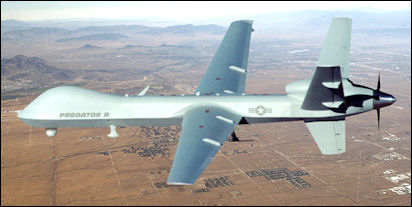
Reaper drone In June 2010, AP reported: “The United States will push ahead with more targeted drone strikes and special operations raids and fewer costly land battles like Iraq and Afghanistan in the continuing war against al-Qaeda, according to a new national counterterrorism strategy unveiled. The doctrine, two years in the making, comes in the wake of the successful special operations raid that killed al-Qaeda chief Osama bin Laden in May. [Source: AP, June 30, 2011]
“The document is a purposeful departure from the Bush administration's global war on terror. White House counterterrorism chief John Brennan said the reworked doctrine acknowledges the growing threat of terrorism at home, including al-Qaeda attempts to recruit and attack inside the United States. Brennan said that more resources would be spent on the fight at home to spot would-be militants and their recruiters, and the U.S. would resist al-Qaeda's attempts to bleed it economically by drawing it into costly invasions overseas.
"Our best offense won't always be deploying large armies abroad, but delivering targeted, surgical pressure to the groups that threaten us," Brennan said at the Johns Hopkins School of Advanced International Studies. Brennan said the strategy relies on "surgical" action against specific groups to decapitate their leadership and deny them safe havens and rejects costly wars like Iraq and Afghanistan that feed al-Qaeda's narrative that America is out to occupy the Muslim world. He said the U.S. would work whenever possible to help host countries fight al-Qaeda so the U.S. didn't have to, just as it was trying to hand over responsibility to the Afghans.
“The operations Brennan describes are almost solely the province of the intelligence and military special operations agencies, especially the CIA and elite forces of the Joint Special Operations Command that worked together to carry out the bin Laden raid, but also including the special operations trainers that work with host nations' militaries. Brennan, who is a former CIA officer, did not make specific mention of the covert armed drone program that targets militants in Pakistan and, on rare occasions, in countries like Yemen. But he referred to the administration's work to rush what he called "unique capabilities" to the field, an oblique reference to classified programs like the stepped-up construction of a CIA drone-launching base in the Persian Gulf region to use the unmanned aircraft to hunt militants in Yemen.
“Bush White House veteran Juan Zarate questioned the wisdom of singling out al-Qaeda as the main American enemy, "inadvertently aggrandizing them when they are in decline, by making them the focus of the strategy." He also questioned the decision to "focus very mechanically on al-Qaeda," with less emphasis on the violent Islamic ideology that drives the group. "You might miss a movement that is developing —or evolving — into a global platform like al-Qaeda, said Zarate, former White House deputy national security adviser for combating terrorism.
Image Sources: Wikimedia Commons
Text Sources: New York Times, Washington Post, Los Angeles Times, Times of London, The Guardian, National Geographic, The New Yorker, Time, Newsweek, Reuters, AP, AFP, Wall Street Journal, The Atlantic Monthly, The Economist, Global Viewpoint (Christian Science Monitor), Foreign Policy, Wikipedia, BBC, CNN, NBC News, Fox News and various books and other publications.
Last updated July 2012

